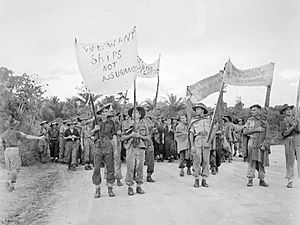Post–World War II demobilization strikes facts for kids

After World War II ended, many soldiers from countries like the United States, Britain, and Australia were still serving far from home. They had fought bravely, but now they wanted to return to their families and normal lives. This led to many protests and strikes by military personnel in places like the Middle East, India, and South-East Asia. These actions were called "demobilization strikes" because the soldiers were demanding to be sent home and released from military service.
Contents
Soldiers Demand to Go Home After World War II
After World War II ended in 1945, millions of soldiers from the Allied forces were still stationed around the world. They had spent years fighting and now wanted to go home. This desire led to many protests and strikes by military personnel in different countries.
Why Soldiers Protested
Soldiers had been away from their families for a long time. They felt their job was done and it was time to return to civilian life. Many were also unhappy with their living and working conditions. For example, in India, British Royal Air Force (RAF) servicemen protested about very hot weather and crowded living spaces. Some even died because of the extreme heat.
Protests Around the World
- In occupied Germany, American soldiers held large parades to demand faster demobilization, which meant being sent home quickly.
- In the Philippines, American soldiers formed special committees and held demonstrations, all asking to return home.
- In India, thousands of RAF servicemen went on strike in 1946. They were upset about their living conditions and the slow process of being sent back to Britain. They even set up a "Forces Parliament", which was like a meeting group where soldiers could discuss their problems and demands.
A Message to the Prime Minister
The issue of soldiers wanting to go home became a big topic in the British Parliament. Prime Minister Clement Attlee received a special message from servicemen stationed in India. The message clearly stated:
"We have done the job we joined up to do. Now we want to get back home, both for personal reasons and because we think it is by work that we can best help Britain. No indication has been given of when we will see our families again. Is it because the government wishes to talk tough with other powers?"
This showed how strongly the soldiers felt about returning home and helping their country recover after the war.
Government Response and Consequences
Some military groups in India were disbanded because leaders worried they might not follow orders if asked to stop protests. The Conservative Party in Britain questioned the new Labour government about the difference between a strike and a mutiny (a rebellion against authority).
Some soldiers who led these protests were arrested. However, public support and pressure from Members of Parliament (MPs) led to their early release or reduced sentences. These protests highlighted the challenges governments faced in bringing millions of soldiers home after a massive global conflict.
See also
- Demobilisation of the Australian military after World War II
- Demobilisation of the British Armed Forces after World War II
- Demobilization of United States armed forces after World War II
- Royal Air Force Mutiny of 1946
- Royal Indian Navy Mutiny of 1946 of Indian sailors also demanded demobilisation
- 1947 Royal New Zealand Navy mutinies
- Cairo Forces Parliament
- Helwan Riots (1945)

